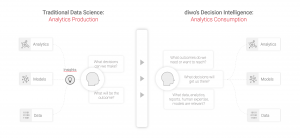
Transforming Business Decisioning in the Pandemic era is more crucial than ever.
Our human tendency toward incremental thinking limited us from foreseeing how “a few cases of the flu” would balloon into the impact we see today. Even in the best of times, we’re wired to think linearly, and our brains often struggle to grasp non-linear relationships. This can have unintended and sometimes disastrous consequences in business. Without a holistic view of our business, we may fail to foresee the ripple effect our decisions will have in the future.
For example, planning which products to stock includes a myriad of decisions, many of which of which are non-linear (volume vs profit, price vs sales, etc.), have strong ripple effects (cannibalization, perception etc.) and are interlinked (impacting the entire supply chain). While siloed insights to assist with these decisions exist in the form of reports, dashboards and visualizations, deriving decisions out of them is simply overwhelming. When reams of data are met with a drastic and unprecedented contextual change, such as the current pandemic, the need for quick and optimal decisions becomes more crucial than ever.
Any enterprise decision-maker will agree that Analytic and AI technologies are generating insights faster than ever. But it’s also painfully obvious to business leaders that the speed and quality of decisions hasn’t kept up.
With multiple limitations standing between analytics output and action, it’s in the “last mile of analytics” that businesses face the biggest challenge. While analytic technologies have evolved at an explosive pace, the process of transforming multiple insights from a variety of sources to a recommendation for action (the last mile) has remained the same for at least the past two decades. The process is manual, slow and dependent on the experience and judgment of analysts.
After years of studying how people like firefighters, pilots and chessmasters make high-stakes decisions in real situations with time pressures, vague goals, limited information and changing conditions, research confirmed that, in reality, most of the time we don’t choose the best option; we choose the first reasonable option (known as “satisficing”). Simply adding more insights for overwhelmed and time-constrained decision-makers to consider won’t help improve these decisions; for better-informed decisions, technology should integrate into humans’ natural decision-making process.
What’s missing is what we call Decision Intelligence, a way to quickly and automatically translate these insights into the best action. Decision Intelligence is an emerging technology that helps businesspeople understand potential decisions and their outcomes, based on their unique business context. In a time-sensitive situation, a Decision Intelligence framework would automatically connect knowledge sources and apply context, making it easy to scale decisions even in a heavily complex, rapidly changing environment.
As we face some of the most challenging and consequential decisions of our lifetimes, the good news is that we have the tools to transform the consumption of Analytics. Decision Intelligence frameworks can connect AI and multiple knowledge sources to help decision makers understand the full context and quantify the impact of their decisions before committing to the best path forward, even in uncertain times such as these.

About the Author:
Having led Creative, Strategy, UX design, and implementation of innovative UI solutions for diverse start-ups and Fortune 500s, Gregory is Principal Interaction Designer at Diwo, a Decision Intelligence Application.